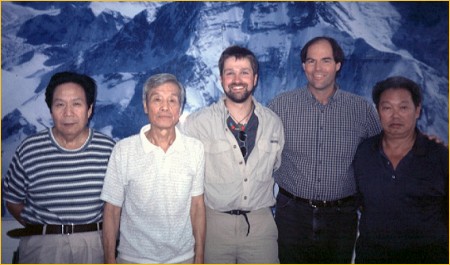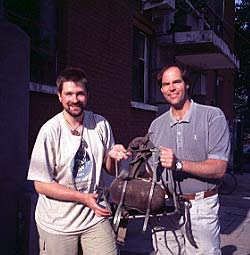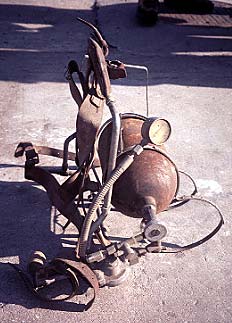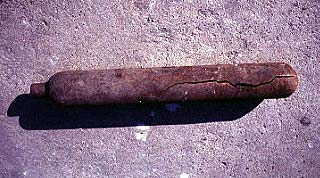
In a 2004 web dispatch EverestNews.com published an exclusive interview with Chinese veteran climber, Xu Jing. Xu Jing had been deputy leader of the 1960 Chinese Everest expedition, in the course of which he reported finding an old body below the Northeast Ridge of Everest. The body was in a location different from where Mallory had been found in 1999, which made it almost a certainty that Xu Jing had discovered Irvine. Xu revealed his finding for the first time in 2001 in an interview with Eric Simonson and me, and a primarily analysis of Xu's testimony was later published in our book, Detectives on Everest (Seattle: The Mountaineers Books, 2002). The key part of the testimony is available here »

F.l.t.r.: Wang Fuzhou, Xu Jing, Jochen Hemmleb, Eric Simonson, and Qu Yinhua,
Beijing, summer 2001 — © Archiv J. Hemmleb, Idstein
In how far does this new interview by EverestNews differ from what Eric Simonson and I heard in Beijing three years ago?
There appears to be a 99% match between what Xu Jing told EverestNews and what we were told by him and other Chinese climbers in 2001. Even smaller details, like seeing a rope ladder from one of the British expedition at Rongbuk Monastery, are consistent.

Jochen Hemmleb and Eric Simonson with Peter Lloyd's oxygen set from 1938, recovered by the Chinese in 1960 at the 1938 Camp V. © Jochen Hemmleb
The discovery in 1960 of Maurice Wilson's body below Advanced Base Camp was actually filmed by the Chinese, and the footage provides a remarkable confirmation of Xu Jing's recent description of the find.
The issue of the oxygen bottles allegedly found near the Second Step was shown to be a mix-up of the various discoveries the Chinese had reported, including the oxygen bottles mentioned above and a rope and tent pole from the 1933 Camp VI site (the issue was first resolved by Tom Holzel in American Alpine Journal, 1983, p. 293f., a comment on the original information and its distribution can be found on www.alpine-history.com).
There is, however, one aspect in the EverestNews interview that differs radically from what was published in Detectives on Everest — the placing of the old body, presumably Irvine, on the ridge between the First and Second Steps. Did this come as a surprise to Eric Simonson and me? Not really.Because this was essentially the same Xu Jing did when we asked him to pinpoint the location on a photograph of the upper Northeast Ridge (Andy Politz's image of Odell's view, Ghosts of Everest, p. 116). He placed the 1960 Chinese assault camp, Camp VII, at the base of the Second Step, and then placed the location of the body nearby, below the ridge crest between the First and Second Step.
Now we knew where the 1960 Camp VII had been — and it was not at the base of the Second Step. The Chinese had placed it initially on the ridge crest some 200 meters before the First Step at 8,460 m (27,750 ft.). Prior to the summit bid they moved it up to a notch in the first rise of the First Step at 8,510 m (27,920 ft.). The altitudes are confirmed by early Chinese reports, and the camps' remnants were found at the locations in 2001 and 2004.
Based on this obvious discrepancy we found Xu's recollection of the body location not totally reliable and decided to question him further. We did not doubt the essence of his testimony, i.e. that he had seen the old body. As our interview went on, Xu then came up with the estimation that the body was some 300 m or two hours away from Camp VII.
A distance of "two hours" of climbing from Camp VII would indeed place the body on the ridge between the First and Second Step — or, when going in the opposite direction, somewhat below the camp, in the Yellow Band below the ridge crest. This would have been more in accordance with the altitudes Xu gave us. He had initially placed the body between 8,200 and 8,300 m (c. 26,900 to 27,230 ft.), later correcting the figure to 8,300-8,400 m (27,230-27,560 ft.). Note also that Xu is recorded as saying he found the body in a crack or gully with steep cliffs on both sides (quoted in Hellen, N., "Body may prove who was first up Everest", The Sunday Times, April 27, 2003), not simply in a location "with steep cliffs on both sides".According to EverestNews, Xu said he discovered the body on May 24, 1960, which was the day of the summit assault. Xu was originally included in the summit party, but had to turn back shortly after leaving Camp VII. We don't know how far Xu climbed out of Camp VII, but from the record it is clear that he didn't get all the way to the Second Step. Xu descended to Camp VI that same day.
If we take the EverestNews information at face value, there is at least some discrepancy between the altitudes Xu gave us (8,300 m, +/- 100 m) and the indicated position of the body on the ridge between the First and Second Step, between c. 8,510 and 8,570 m (27,920-28,120 ft.).
There are three routes out of the 1960 Camp VII into this area, all of which have now been followed several times: along the crest of the First Step, via the open gully on the step's northern face (most common route), or bypassing the step and regaining the ridge immediately beyond (Japanese 1980, Catalans 1985) — albeit with no reported rediscovery of the body. In addition, the EverestNews information leaves us with two important questions:
How can we reconcile Irvine's body that high up with Mallory's body down below on the snow terrace with a broken rope around his waist?
How can we reconcile Irvine's body in this position with his ice-axe found lower down and horizontally some 300 meters away??
Eric Simonson's and my interpretation of Xu Jing's testimony in 2001, as published in Detectives on Everest, would have placed Irvine's body on a possible descent route from the ice-axe site and in the area of Mallory's suspected fall (see also the earlier ExWeb article by Pete Poston and myself). The new EverestNews information does neither.
All images © Jochen Hemmleb, 2001
| Proud Climbing Team of the Mallory & Irvine Research Expeditions: | ||

